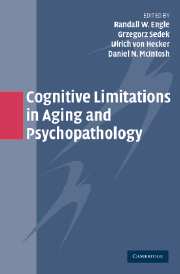Book contents
- Frontmatter
- Contents
- List of Contributors
- Preface
- Acknowledgments
- 1 Cognitive Limitations in Aging and Psychopathology: An Introduction and a Brief Tutorial to Research Methods
- SECTION I WORKING MEMORY AND COGNITIVE FUNCTIONS
- 2 Working Memory Capacity in Hot and Cold Cognition
- 3 Age Differences and Individual Differences in Cognitive Functions
- 4 Stress and Working Memory: Between-Person and Within-Person Relationships
- SECTION II AGING AND PSYCHOPATHOLOGY OF COGNITIVE CONTROL
- SECTION III ATTENTION, INHIBITION, AND REASONING PROCESSES
- Name Index
- Subject Index
- References
4 - Stress and Working Memory: Between-Person and Within-Person Relationships
Published online by Cambridge University Press: 20 May 2010
- Frontmatter
- Contents
- List of Contributors
- Preface
- Acknowledgments
- 1 Cognitive Limitations in Aging and Psychopathology: An Introduction and a Brief Tutorial to Research Methods
- SECTION I WORKING MEMORY AND COGNITIVE FUNCTIONS
- 2 Working Memory Capacity in Hot and Cold Cognition
- 3 Age Differences and Individual Differences in Cognitive Functions
- 4 Stress and Working Memory: Between-Person and Within-Person Relationships
- SECTION II AGING AND PSYCHOPATHOLOGY OF COGNITIVE CONTROL
- SECTION III ATTENTION, INHIBITION, AND REASONING PROCESSES
- Name Index
- Subject Index
- References
Summary
The individual differences construct of working memory capacity (WMC) is a topic of increasing interest in cognitive psychology. The primary reason for this interest stems from research that demonstrates consistently strong relationships between measures of WMC and higher order cognitive function, such as fluid intelligence (Engle, Tuholski, Laughlin, & Conway, 1999). In addition to being an important predictor of psychometric measures of intellectual ability, WMC predicts performance on standardized achievement tests and grade point average (Cantor, Engle, & Hamilton, 1991; Engle et al., 1999). According to Engle et al. (1999) and Engle (2002), WMC reflects the ability to maintain relevant information in the focus of attention in the face of irrelevant and distracting stimuli. Engle and colleagues (Engle et al., 1999; Unsworth, Heitz, & Engle, this volume) argued that WMC is a central component of fluid intelligence and, hence, is a cognitive primitive.
Although WMC is often viewed as a stable trait, some theorists have argued that changes in arousal, motivation, and the experience of stress can produce fluctuations in attentional reserve (Eysenck & Calvo, 1992; Kahneman, 1973; Hasher & Zacks, 1988). Consistent with this view, recent research suggests that the experience of even mild life-event stress might impair working memory performance (Klein & Boals, 2001a) and that interventions that ameliorate the effects of stress can improve working memory (Klein & Boals, 2001b). One theoretical account of this relationship proposes that the experience of stress leads to the subsequent experience of intrusive or worrisome thoughts.
- Type
- Chapter
- Information
- Cognitive Limitations in Aging and Psychopathology , pp. 73 - 94Publisher: Cambridge University PressPrint publication year: 2005
References
- 3
- Cited by



